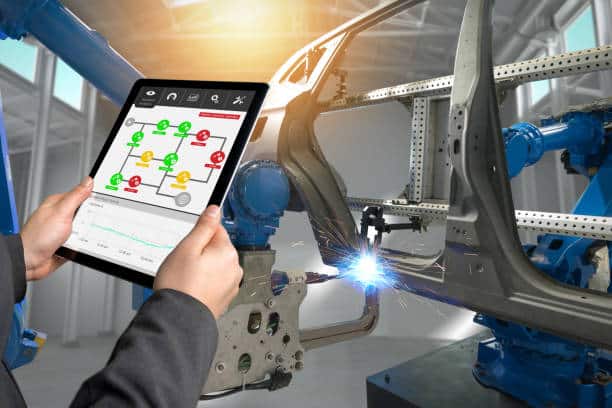Heavy industry relies on complex machinery in manufacturing plants, power grids, extensive mines, and complex transportation networks.
Any spectacular collapse can lead to massive monetary misfortunes and operational explosions. This is where the combination of IoT (Web of Things) and human-generated intelligence (Computerized reasoning) changes the support landscape.
From Responsive to Proactive: The Upkeep Transformation

All things considered, weighted industry support rehearsals are generally responsive – fix it when it breaks. In any case, IoT sensors currently produce a consistent stream of information about the well-being of the hardware, preparing a proactive methodology boosted by the scientific ability of computer-based intelligence. We should explore how computer-based intelligence makes this intelligible:
- Computer-based intelligence, the Expert Example Identifier: computer-based intelligence-based controlled frameworks enthusiastically search through continuous sensor information, addressing subtle anomalies that often precede breakdowns. These deviations from the norm can be anything from unusual vibration patterns to temperature fluctuations.
- Human Intelligence as Your Symptomatic Teacher Investigating verifiable support records and extracting nuggets of knowledge, AI models can identify potential root causes of expected disappointments. This means faster investigation and fixed fixes.
- Continuously learning humanoid intelligence: As humanoid intelligence frameworks absorb more information, they improve their ability to predict equipment problems. Predictions become increasingly accurate as a result of this virtuous cycle.
- The Benefits: Why Simulated Intelligence in Prescient Support Matters Limiting the Beast of Personal time: Preventive maintenance helps organizations stay ahead of frustrations, effectively reducing downtime and those dreaded operational stops.
- Reality Protection: Lowering the cost of fixing, preventing unexpected horrible disappointments, and increasing resource life expectancy all add up to better funds.
- Increase efficiency: human intelligence enhances support bookings, focuses on key resources, automates work orders and streamlines MRO (Maintenance, Repair and Operations) processes.
Human intelligence-driven proactive support:
A Brief Outline Predictive maintenance based on intelligence simulation refers to a change in perspective in how businesses deal with the unwavering quality of their equipment.
Through the integration of cutting-edge research and artificial intelligence, AI is changing the way associations approach support processes.
AI models are capable of detecting patterns and anomalies indicative of potential equipment failures by meticulously collecting and analyzing extensive data sets that include sensor readings, historical records and operational parameters.
Comparison of AI-based predictive maintenance with traditional maintenance
Proactive support is a critical element in improving operational productivity. The following sections illustrate key differences between conventional and AI-based approaches, revealing insight into the pioneering impact of man-made brainpower in maintenance trials.
Conventional predictive support operates reactively, resolving issues after the event and depends on verifiable information. This responsive nature often causes uncertain timing and understanding of frustrations.
Simulated intelligence advances used in proactive support

Computer-based intelligence includes several advances that add to the viability of preventive maintenance. Key AI advances in this area include:
- AI: ML computing is key to predictive maintenance by dissecting verifiable information to distinguish designs and predict future discovery of hardware problems.
- Deep Learning: Deep learning, a subset of ML, is particularly viable for handling overwhelming and massive datasets. Brain networks in DL models can thus learn various flattened representations of information, making them suitable for tasks such as image recognition and signal manipulation in predictive support applications.
- Normal language manipulation: NLP examines text-based information, such as support reports, adding to a deeper understanding of material well-being by extracting bits of knowledge from unstructured information. Coordinates data, creating information bases for easy entry into authentic records and investigative guides. NLP-powered chatbots and friendly assistants provide continuous assistance, ensuring quick access to fundamental data for stronger decision-making among maintenance personnel.
You’re putting your money on AI for the long term
By embracing human controlled intelligence proactive support, modern associations can guarantee a more economical future. Reduced break-even time means lower power usage and a more moderate physical impression. Additionally, advancing tool life reduces asset consumption associated with incessant hardware replacements.
Embracing what is

Producers should understand that aligning AI with control and maintenance tasks isn’t just a worthy additional upgrade, however it’s a key element to remain spontaneous in the advanced modern scene.
The experiences and robotics presented by AI-driven preventive maintenance are unparalleled, guaranteeing longevity and unwavering quality of hardware, but additionally adding to the overall functional magnificence.
As the assembly business continues to explore the challenges of the 21st century, the adoption of human intelligence for observation and preventive maintenance is not only an innovative methodology. it is an important stage to ensure strength, productivity and sustained growth.
Try not to let your operations fall behind – leverage computer-based intelligence to unlock the true potential of your assembly processes, ensuring they are robust, productive and ready for the vulnerabilities of the future.
conclusion
The combination of artificial intelligence in proactive support has ushered in another era of efficiency and reliability in all businesses. Organizations can adopt dynamic data-driven strategies instead of traditional fixed-schedule maintenance methods by leveraging the power of core technologies.
Optimized maintenance schedules, early fault detection and significant cost reductions are all examples of the benefits of predictive maintenance with artificial intelligence. As innovation advances, AI capabilities in preventive maintenance will increase, yielding progressively more sophisticated responses to meet the needs of the growing industry.
Adopting simulated intelligence is not just an engineering choice, but an essential goal, engaging associations to keep up with intensity, moderate risks, and unlock the maximum capacity of their resources.

